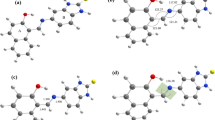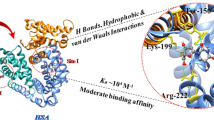Abstract
A bromine-substituted hydrazone derivative, named N′-(4-bromobenzylidene)-2-hydroxybenzohydrazide (BBH), and its unsubstituted analogue, named N′-benzylidene-2-hydroxybenzohydrazide (BH), have been synthesized by a simple and effective one-pot synthesis method. Their interactions with human serum albumin (HSA) were comprehensively studied employing spectroscopy, electrochemistry, and molecular docking. Our attention was largely on the thermodynamic properties of their binding to HSA, in order to evaluate the impact of a bromine atom in BBH to its biological activity comparing to BH. BBH is a stronger ligand with a binding constant of 105 L·mol−1 and formed a more stable complex with HSA compared with BH. The binding processes of both BBH and BH are mainly an enthalpy driven process occurring in site I, mainly bound by hydrogen bonding and the van der Waals force.





Similar content being viewed by others
References
Tian, F.-F., Jiang, F.-L., Han, X.-L., Xiang, C., Ge, Y.-S., Li, J.-H., Zhang, Y., Li, R., Ding, X.-L., Liu, Y.: Synthesis of a novel hydrazone derivative and biophysical studies of its interactions with bovine serum albumin by spectroscopic, electrochemical, and molecular docking methods. J. Phys. Chem. B 114, 14842–14853 (2010)
Rollas, S., Küçükgüzel, Ş.: Biological activities of hydrazone derivatives. Molecules 12, 1910–1939 (2007)
Lovejoy, D., Richardson, D.: Novel “hybrid” iron chelators derived from aroylhydrazones and thiosemicarbazones demonstrate selective antiproliferative activity against tumor cells. Blood 100, 666–676 (2002)
Kalinowski, D., Sharpe, P., Bernhardt, P., Richardson, D.: Design, synthesis, and characterization of new iron chelators with anti-proliferative activity: structure–activity relationships of novel thiohydrazone analogues. J. Med. Chem. 50, 6212–6225 (2007)
Kucukguzel, S., Oruc, E., Rollas, S., Sahin, F., Ozbek, A.: Synthesis, characterization and biological activity of novel 4-thiazolidinones, 1,3,4-oxadiazoles and some related compounds. Eur. J. Med. Chem. 37, 197–206 (2002)
Himmel, D., Sarafianos, S., Dharmasena, S., Hossain, M., McCoy-Simandle, K., Ilina, T., Clark, A., Knight, J., Julias, J., Clark, P., Krogh-Jespersen, K., Levy, R., Hughes, S., Parniak, M., Arnold, E.: HIV-1 reverse transcriptase structure with RNase H inhibitor DHBNH bound at a novel site. ACS Chem. Biol. 1, 702–712 (2006)
Dimmock, J., Vashishtha, S., Stables, J.: Anticonvulsant properties of various acetyl hydrazones, oxamoyl hydrazones and semicarbazones derived from aromatic and unsaturated carbonyl compounds. Eur. J. Med. Chem. 35, 241–248 (2000)
Bukowski, L., Janowiec, M., Zwolska-Kwiek, Z., Andrzejczyk, Z.: Synthesis and some reactions of 2-acetylimidazo[4,5-b]pyridine. Antituberculotic activity of the obtained compounds. Pharmazie 54, 651–654 (1999)
Emsley, J.: Nature’s building blocks: an A–Z guide to the elements. Oxford University Press, New York (2001)
Gribble, G.: The diversity of naturally occurring organobromine compounds. Chem. Soc. Rev. 28, 335–346 (1999)
Gribble, G.: Naturally occurring organohalogen compounds. Acc. Chem. Res. 31, 141–152 (1998)
Cuenca, R., Pories, W., Bray, J.: Bromine levels in human serum, urine, hair. Biol. Trace Elem. Res. 16, 151–154 (1988)
Flury, M., Papritz, A.: Bromide in the natural environment: occurrence and toxicity. J. Environ. Qual. 22, 747–758 (1993)
Fisher, D., Burton, D., Yonkos, L., Turley, S., Ziegle, G.: The relative acute toxicity of continuous and intermittent exposures of chlorine and bromine to aquatic organisms in the presence and absence of ammonia. Water Res. 33, 760–768 (1999)
Tian, F.-F., Li, J.-H., Jiang, F.-L., Han, X.-L., Xiang, C., Ge, Y.-S., Li, L.-L., Liu, Y.: The adsorption of an anticancer hydrazone by protein: an unusual static quenching mechanism. RSC Adv. 2, 501–513 (2012)
Han, X.-L., Mei, P., Liu, Y., Xiao, Q., Jiang, F.-L., Li, R.: Binding interaction of quinclorac with bovine serum albumin: a biophysical study. Spectrochim. Acta A 74, 781–787 (2009)
Hu, Y.-J., Liu, Y., Wang, J., Xiao, X.-H., Qu, S.-S.: Study of the interaction between monoammonium glycyrrhizinate and bovine serum albumin. J. Pharm. Biomed. Anal. 36, 915–919 (2004)
Li, R., Jiang, F.-L., Xiao, Q., Li, J.-H., Yu, Q., Liu, Y., Zeng, C.: Microcalorimetric, spectroscopic and microscopic investigation on the toxic effects of CdTe quantum dots on Halobacterium halobium R1. Nanotechnology 21, 475102 (2010)
Valeur, B.: Molecular fluorescence: principles and applications. Wiley-VCH, Weinheim (2001)
Sahoo, B.-K., Ghosh, K.-S., Dasgupta, S.: Molecular interactions of isoxazolcurcumin with human serum albumin: spectroscopic and molecular modeling studies. Biopolymers 91, 108–119 (2008)
Chen, J., Jiang, X.-Y., Chen, X.-Q., Chen, Y.: Effect of temperature on the metronidazole–BSA interaction: multi-spectroscopic method. J. Mol. Struct. 876, 121–126 (2008)
Xiao, Q., Huang, S., Liu, Y., Tian, F.-F., Zhu, J.-C.: Thermodynamics, conformation and active sites of the binding of Zn–Nd hetero-bimetallic Schiff base to bovine serum albumin. J. Fluoresc. 19, 317–326 (2009)
Hu, Y.-J., Ou-Yang, Y., Bai, A.-M., Zhao, R.-M., Liu, Y.: A series of novel rare earth molybdotungstosilicate heteropolyoxometalates binding to bovine serum albumin: spectroscopic approach. Biol. Trace Elem. Res. 136, 8–17 (2009)
Zhang, Y.-Z., Xiang, X., Mei, P., Dai, J., Zhang, L.-L., Liu, Y.: Spectroscopic studies on the interaction of Congo Red with bovine serum albumin. Spectrochim. Acta A 72, 907–914 (2009)
Hu, Y., Ou-Yang, Y., Dai, C.-M., Liu, Y., Xiao, X.-H.: Site-selective binding of human serum albumin by palmatine: spectroscopic approach. Biomacromolecules 11, 106–112 (2010)
Zhang, Y.-Z., Dai, J., Zhang, X.-P., Yang, X., Liu, Y.: Studies of interaction between Sudan I and bovine serum albumin by spectroscopic methods. J. Mol. Struct. 888, 152–159 (2008)
Zhang, Y.-Z., Zhang, X.-P., Hou, H.-N., Dai, J., Liu, Y.: Study on the interaction between Cu(phen) 2+3 and bovine serum albumin by spectroscopic methods. Biol. Trace Elem. Res. 121, 276–287 (2008)
Zhou, B., Zhang, Z., Zhang, Y., Li, R., Xiao, Q., Liu, Y., Li, Z.-Y.: Binding of cationic porphyrin to human serum albumin studied using comprehensive spectroscopic methods. J. Pharm. Sci. 98, 105–113 (2009)
Acknowledgments
The authors gratefully acknowledge financial support of the National Natural Science Foundation of China (Grant No. 21173026, 20921062), Program for Changjiang Scholars and Innovative Research Team in University (IRT1030).
Author information
Authors and Affiliations
Corresponding authors
Rights and permissions
About this article
Cite this article
Tong, JQ., Tian, FF., Liu, Y. et al. Thermodynamic Properties of the Site-selective Binding of a Bromo-hydrazone and Its Unsubstituted Analogue to Human Serum Albumin. J Solution Chem 44, 193–205 (2015). https://doi.org/10.1007/s10953-015-0303-7
Received:
Accepted:
Published:
Issue Date:
DOI: https://doi.org/10.1007/s10953-015-0303-7




